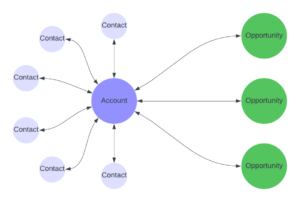How Contact Roles Impact Marketing Attribution
If you’ve worked in the operations space for any length of time, you’re aware of Opportunity Contact Roles (OCRs), how they work, and why they’re important. But, one thing that comes up a lot when we work with clients on marketing attribution is how OCRs impact marketing attribution. So, let’s talk about it a bit.
What’s an OCR?
Before we start talking about how OCRs impact marketing attribution, let’s do a little level set on what they are.
In Salesforce (SFDC), there is an automatic relationship created between the Account and the Opportunity. But, there isn’t an automatic relationship created between the Contact(s) associated with the Account and the Opportunity.
There are two exceptions to the rule above…
- When the Opportunity is created as part of the Lead conversion process
- When the Opportunity is created from the Contact page
Outside of those two exceptions, SFDC does not create an automatic relationship between Contacts and Opportunities. That’s because each Account can have multiple Contacts and there’s no way for SFDC to know exactly which Contacts should be related to the Opportunity. Plus, there could be multiple Opportunities with different contacts.
Enter the OCR. The OCR is how SFDC allows users to create many-to-many relationships between Contacts and Opportunities. Outside of the two exceptions above, OCRs have to be manually applied to the Opportunity. That means that they’re tough to enforce or make sure they happen regularly. But, that’s basically what they are… just a way to create a relationship between multiple Contacts and multiple Opportunities.
Contact Roles and Attribution
When it comes to attribution, OCRs can play a pivotal role in the process.
If you’re using entry-level attribution–such as the Campaign Influence process in SFDC or Marketo’s multi-touch process–OCRs are mandatory for attribution. You have to have them, otherwise, the marketing engagement can’t be related to the Opportunities.
When using advanced marketing attribution tools–such as Bizible, CaliberMind, Dreamdata and so on–OCRs are not required. These tools typically come out of the box using an account-based approach to attribution. Then, they give you the opportunity to choose between account-based attribution or contact role-based attribution. So, what’s the difference?
Account-based attribution means that all Contacts associated with the Account will factor into the attribution story for any given Opportunity.

Contact Role-based attribution means that only the Contacts associated with the Opportunity via the OCR will factor into the attribution story for any given Opportunity.
Which methodology is right?
It’s not a matter of which methodology is right… but rather, which methodology is right for your organization.
Account-based attribution is a better fit for organizations that don’t use OCRs often, or well.
Contact Role-based attribution is a better fit for organizations that do use OCRs often, and well. This will give you a more laser-focused view of your attribution.
There’s another interesting use-case for Contact Role-based attribution, and that’s when you need to associate Contacts from another Account into the attribution story for an Opportunity.
Let’s set up an example. Imagine that you are an organization that markets to brokers. And, those brokers refer deals to you. But, the purchaser, and the end user, is tied to a different Account than the Account the broker sits in. But, you want to be able to attribute your marketing to the broker to any Opportunities that come from those referrals, and thus, the marketing. In order to do that, you have to associate the broker to the Opportunity via the OCR. That’s the only way to complete that picture.
So, OCRs can provide a more laser-focused attribution picture. AND, they can also help broaden the scope by allowing you to see attribution across multiple Accounts.
We hope this helps paint a clearer picture about how OCRs play a role in attribution, and the pros and cons of using them. Give a shout if you have any questions!

